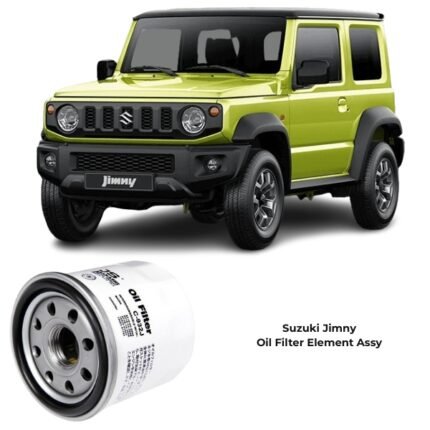Get Suzuki Jimny Fan Belt 4PK985 in Kenya
The Fan Belt, also commonly known as the Drive Belt or Serpentine Belt (depending on design), is one of the most vital components in a vehicle’s engine system. Although it may appear as a simple rubber loop, its role in the operation and coordination of multiple engine accessories cannot be overstated. The fan belt transfers mechanical power from the engine’s crankshaft to essential components such as the alternator, water pump, power steering pump, and air conditioning compressor. Without it, these systems would fail to function, leading to overheating, electrical discharge, and complete vehicle breakdown.
1. Purpose and Function
The primary purpose of the fan belt is to transfer rotational energy from the engine’s crankshaft pulley to other peripheral components that rely on engine power. The belt’s continuous loop ensures synchronized operation, keeping multiple systems running efficiently.
Here are the main functions the fan belt supports:
-
Cooling System: Drives the water pump to circulate coolant throughout the engine, preventing overheating.
-
Electrical System: Powers the alternator, which charges the vehicle’s battery and runs electrical systems.
-
Steering System: Operates the power steering pump, allowing easy and responsive steering control.
-
Air Conditioning: Drives the A/C compressor, enabling the cooling function inside the cabin.
-
Air Pump or Other Accessories: In some engines, it also powers emission control or air injection pumps.
In essence, the fan belt acts as the link between the engine’s power source and all auxiliary systems, making it indispensable to smooth and safe vehicle operation.
2. Construction and Material Composition
The fan belt is designed to endure high tension, temperature fluctuations, and continuous motion. To achieve this, manufacturers use high-strength materials that combine flexibility, durability, and resistance to wear.
Key components include:
-
Rubber Matrix: Traditionally made from neoprene or EPDM (Ethylene Propylene Diene Monomer), which provides flexibility and resistance to cracking, oil, and heat.
-
Tensile Cords: Embedded within the rubber body, these cords (usually made from polyester, Kevlar, or fiberglass) provide tensile strength to resist stretching under high load.
-
Fabric Layer: The outer surface often has a fabric or nylon coating that enhances wear resistance and protects against friction.
-
Grooves or Ribs: Modern belts (especially serpentine belts) feature multiple longitudinal ribs that align with pulley grooves, increasing grip and preventing slippage.
This combination of materials allows the belt to maintain its structural integrity under constant stress and heat, ensuring a long service life.
3. Types of Fan Belts
Over the years, the design of fan belts has evolved to suit modern engines’ increasing demands. The main types include:
-
V-Belt: The traditional type with a V-shaped cross-section that fits into corresponding pulley grooves. It provides excellent traction and is used in older vehicles or in systems with separate belts for each accessory.
-
Serpentine Belt: A modern, flat belt with multiple ribs running lengthwise. It drives multiple accessories simultaneously through a single continuous loop. It is more efficient, requires less space, and is easier to maintain.
-
Cogged V-Belt: A variation of the standard V-belt with notches or cogs on the inner surface to improve flexibility and cooling, commonly used in high-performance engines.
-
Timing Belt (though distinct): Sometimes confused with the fan belt, but it serves a different purpose—synchronizing the camshaft and crankshaft.
Each type is engineered for specific vehicle configurations and performance requirements.
4. Working Principle
The fan belt operates on a simple but efficient mechanical transmission principle. As the engine’s crankshaft rotates, it drives the belt, which in turn spins the pulleys connected to various accessories.
The tensioner (either manual or automatic) ensures the belt remains tight enough to prevent slippage while allowing slight flexibility for expansion and contraction due to heat. Idler pulleys help guide the belt along its path, maintaining alignment and reducing vibration.
In operation:
-
The crankshaft pulley turns the belt.
-
The belt transfers motion to the accessory pulleys.
-
Each accessory converts the rotational energy into its own form of mechanical work (e.g., the alternator generates electricity, the water pump circulates coolant, etc.).
This synchronized system keeps all engine accessories working efficiently in harmony.
5. Importance in Engine Operation
The fan belt is crucial for several reasons:
-
Prevents Engine Overheating: By driving the water pump, it ensures proper coolant circulation.
-
Maintains Electrical Power: Powers the alternator, ensuring the battery remains charged and all electrical systems function properly.
-
Ensures Smooth Steering: Operates the power steering pump, reducing steering effort.
-
Provides Cabin Comfort: Enables air conditioning and ventilation systems.
-
Supports Emission Control: In some engines, it drives emission control pumps for cleaner exhaust.
Without the fan belt, the engine cannot operate for long; within minutes, overheating and power loss would occur.
6. Signs of Wear or Failure
Like all rubber-based components, the fan belt is subject to wear, aging, and eventual failure. Recognizing warning signs early helps prevent breakdowns or engine damage.
Common indicators include:
-
Squealing or Chirping Noise: Usually caused by slippage, misalignment, or loss of tension.
-
Visible Cracks or Fraying: Indicate the belt has aged or been exposed to excessive heat.
-
Glazing or Shiny Surface: Caused by slippage or contamination with oil or coolant.
-
Loss of Power Steering or Electrical Issues: May result from a broken or slipping belt.
-
Engine Overheating: When the belt fails to drive the water pump effectively.
-
Dashboard Warning Lights: Especially the battery or alternator light, indicating the belt is not powering the alternator.
If the fan belt snaps while driving, the engine may continue running briefly but will quickly overheat and lose electrical and steering assistance.
7. Maintenance and Replacement
Routine inspection and timely replacement are essential for ensuring optimal belt performance. Most modern fan belts made from EPDM can last between 80,000 and 150,000 kilometers, but this varies depending on driving conditions and engine design.
Maintenance Tips:
-
Visual Inspection: Check for cracks, fraying, or uneven wear every few thousand kilometers.
-
Tension Check: Ensure proper tightness. A belt that’s too loose can slip; one that’s too tight can strain pulleys and bearings.
-
Cleanliness: Keep the belt and pulleys free of oil, coolant, or debris.
-
Alignment: Ensure pulleys are properly aligned to prevent uneven wear.
-
Replacement Schedule: Always follow the manufacturer’s recommended replacement interval.
Replacement Procedure:
-
Disconnect the battery for safety.
-
Release tension from the tensioner pulley.
-
Remove the old belt from the pulleys.
-
Route the new belt according to the diagram on the engine bay.
-
Reapply tension and double-check alignment before starting the engine.
A properly maintained fan belt ensures the reliability and efficiency of all engine accessories.
8. Design Innovations and Modern Technology
Modern engines employ advanced serpentine belt systems with automatic tensioners and durable EPDM materials that resist cracking and hardening. Belt routing has also been optimized to reduce noise and vibration while improving efficiency.
Some high-end vehicles incorporate stretch-fit belts, which eliminate the need for tensioners, reducing complexity and friction losses. Additionally, micro-V designs and multi-ribbed patterns enhance grip and reduce slippage under high torque loads.
Hybrid and electric vehicles, although less dependent on mechanical belts, still use them in auxiliary systems where mechanical-to-electrical energy transfer is necessary.
9. Consequences of Neglecting the Fan Belt
Neglecting the fan belt can lead to severe engine and vehicle problems:
-
Overheating: Due to the failure of the water pump.
-
Battery Discharge: When the alternator stops charging.
-
Loss of Power Steering: Making vehicle control difficult and unsafe.
-
A/C Malfunction: Resulting in discomfort during hot conditions.
-
Engine Damage: If overheating persists, it can lead to warped cylinder heads or blown gaskets.
Thus, a broken or neglected fan belt can immobilize a vehicle entirely.
Follow us on Facebook for more parts.





Reviews
Clear filtersThere are no reviews yet.